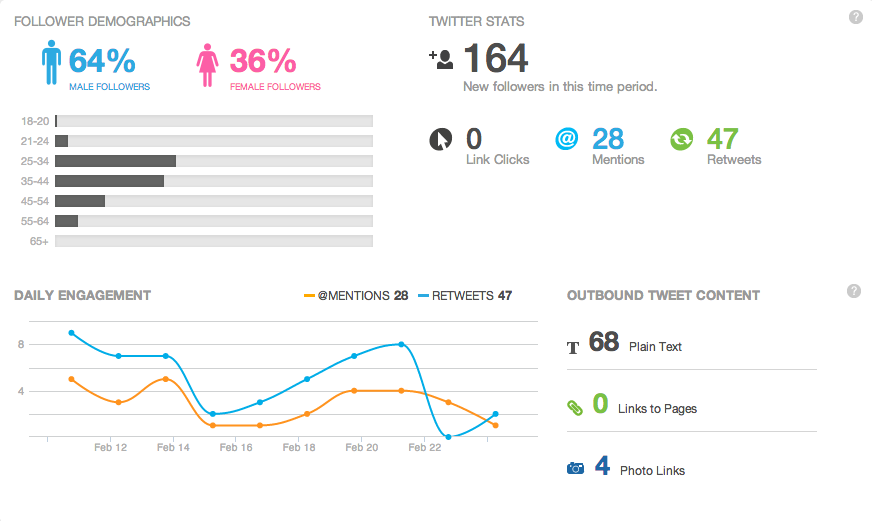Social media is becoming more and more popular for businesses as they continue (or begin) to recognize the great benefits it can have. From recruiting, to leads, to brand awareness, and everything in between, social media can do a lot of good for companies looking to boost their client base, and overall, their business.
But all too often, we see businesses hastily organize an approach for social media without taking much time to think actual strategy. And inevitably, that means that they’ll miss out on important parts of a well-rounded social media presence.
One critical element of a well-rounded social media presence that businesses new to social media often overlook is analytics. Whether because they don’t know that analytics for social media actually exist, because they don’t know what tool to use, or even because they just don’t really care, many businesses skip the analytics step and spend a lot of time posting without ever looking into the actual stats of what they’re publishing.
And I’m here to tell you that that’s a very big mistake.
There are several reasons why you shouldn’t forget about analytics when putting together an effort for social media for your business, and the reasons I’ve listed below are only a few:
· Tracking analytics allows you to see what’s working and what isn’t (and make strategy changes accordingly).
By tracking analytics like you see above, you’ll know your number of retweets, clicks (if you use a link shortener), @mentions, and what tweets were most popular by all of those measurements. With more advanced tools, you’ll also know how many impressions you got, who you got in front of, and above all, whether or not the content you’re publishing is useful to the audience you’re trying to target.
Knowing all of these metrics helps make strategy changes as needed–if what you’re publishing isn’t getting any interaction whatsoever, it may be time to rethink what you’re posting–and also helps you make minor tweaks to make sure you’re on-point as time goes on.
· Knowing how many people you’re getting in front of–and whether or not they’re the right audience–can help you loosely measure ROI.
Social media ROI may be hard to (directly) track at this point, but that doesn’t mean there aren’t ways you can help see what your money’s getting you. A traditional advertising stat, overall impressions, lets you know exactly how many people you got in front of–something you can compare to other tools like Google AdWords, or even a traditional radio or billboard ad, to see the value you’re getting from social media.
Social media also has the benefit, with the right execution, of being extremely targeted, and analytics help you track who you’re getting in front of to make sure they’re the right people. While a traditional ad shows itself to millions of unrelated people, you can target a very specific group of people through your efforts on Facebook, Twitter, and other platforms, further increasing your value and letting you see what’s happening with the resources you’re putting into social media.
· Even if you’re not sure how to use it now, tracking your data from the beginning can help you down the road.
Finally, tracking analytics now pays dividends down the road. Something as simple as tracking your impressions, followers, likes, etc. in an excel spreadsheet can help you six months down the road when it’s time to make strategic decisions about where you should go next on social media.
Don’t let a rudimentary understanding of social media hold you back from tracking data now; when it’s time to really step up your game, you’ll be glad that you took the time to track your progress from the beginning.
We use Sprout Social for most of our social media management (the analytics you see at the top of this article are copied straight out of Sprout), but getting analytics doesn’t necessarily have to mean paying for a social media management client.
Free tools like Twitonomy may not be perfect, but they’re a heck of a lot better than working without analytics, and still hit on important metrics like your most popular tweets, what’s retweeted, etc., etc. You’ll generally need a more complex tool to track things like overall impressions, but even looking at what content is shared and what isn’t is a great way to get started.
Social media isn’t nearly as ‘soft’ of a toolset as many business owners believe; tracing direct ROI may be more difficult (at this point), but it’s still very much possible to track interactions, popular tweets, follower growth per week, and overall impressions (among other things), all of which can help you see exactly what your investment into social media is getting you. And I’d expect for that ability to track to only continue to grow over time.
Social media ROI may be hard to track directly, but that’s hardly an excuse to go on social media and not track analytics. So go give some basic analytics tools a try–you might be surprised at what you find.





